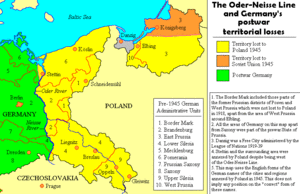Territorial changes of Poland immediately after World War II
| Territorial evolution of Poland in the 20th century |
|---|


At the end of
Decision
These decisions were in accordance with the decisions made first by the Allies at the Tehran Conference of 1943 where the Soviet Union demanded the recognition of the line proposed by British Foreign Secretary Lord Curzon in 1920.[3]
The same Soviet stance was repeated by
I remember at Potsdam, we got to discussing a matter in eastern Poland, and it was remarked by the Prime Minister of Great Britain that the Pope would not be happy over the arrangement of that Catholic end of Poland. And the Generalissimo, the Prime Minister of Russia leaned on the table, and he pulled his mustache like that, and looked over to Mr. Churchill and said: Mr. Churchill, Mr. Prime Minister, how many divisions did you say the Pope had?[5]
Large territories of Polish Second Republic
Population transfer
The population transfer of both Polish and Germans 1945–46 included many millions of people.[7][8] The Polish territory in 1919–39 covered an area of 386,418 square kilometres (149,197 square miles).[9] But from 1947, Poland's territory was reduced to 312,679 square kilometres (120,726 square miles), so the country lost 73,739 square kilometres (28,471 square miles) of land. This difference amounts almost to the size of the Czech Republic, although Poland ended up with a much longer coastline on the Baltic Sea compared to its 1939 borders. In addition, the infrastructure in the former eastern territories of Germany was more developed than in the territories ceded to the Soviet Union.[citation needed]
Outcome
The prewar eastern Polish territories of Kresy, which the Red Army had overrun during the Nazi-Soviet invasion of Poland in 1939 (excluding the Białystok region) were permanently ceded to the USSR by the new Polish communist government, and most of their Polish inhabitants expelled. As a result of the Potsdam Agreement to which Poland's government-in-exile was not invited, Poland lost 179,000 square kilometres (69,000 square miles) (45%) of prewar territories in the east, including over 12 million citizens of whom 4.3 million were Polish-speakers. Today, these territories are part of sovereign Belarus, Ukraine, and Lithuania.[10]
In turn, postwar Poland was assigned considerably smaller territories to the west including the prewar
The German population who had stayed at or had returned to their homes were forcibly expelled before these Recovered Territories (official term) were repopulated with Poles from Central Poland and by Poles expelled from the eastern regions and those from central Poland. The borders of Poland resembled the borders of the German-Russian gains in World War 2, with the exception of the city of Bialystok. This is called the Curzon line. The small area of Trans-Olza, which had been annexed by Poland in late 1938, was returned to Czechoslovakia on Stalin's orders.
See also
- Former eastern territories of Germany
- Geography of Poland
- German–Polish Border Treaty of 1990
- Molotov–Ribbentrop Pact
- Peace of Riga
- Polish–Soviet border agreement of August 1945
- Polish–Soviet War
- Territorial evolution of Poland
- Territories of Poland annexed by the Soviet Union
- Treaty of Zgorzelec of 1950
References
- .
- .
- ^ U.S. Department of State. "The Tehran Conference, 1943 - 1937–1945". Milestones - Office of the Historian. Retrieved 17 December 2015.
{{cite journal}}: Cite journal requires|journal=(help) - ^ ISBN 978-0-306-81650-5.
- ^ "President Truman Speaks to the Scientists", Bulletin of the Atomic Scientists, 4/10, (October 1, 1948): p 292,
- ISBN 978-0-88033-174-6.
- ISBN 978-1-5361-1035-7. Archived from the original(PDF) on 2015-06-23.
- ISBN 978-83-61590-46-0.
- ^ Swedish encyclopedia Nordisk familjebok second edition, article "Polen" , fifth row at [1]
- ^ Sylwester Fertacz, "Krojenie mapy Polski: Bolesna granica" (Carving of Poland's map). Alfa. Retrieved from the Internet Archive on 14 November 2011.
External links
- Moving Poland Western and Northern Lands - Information provided by the Polish History Museum
- Interactive map of pre-war and post-war Poland
